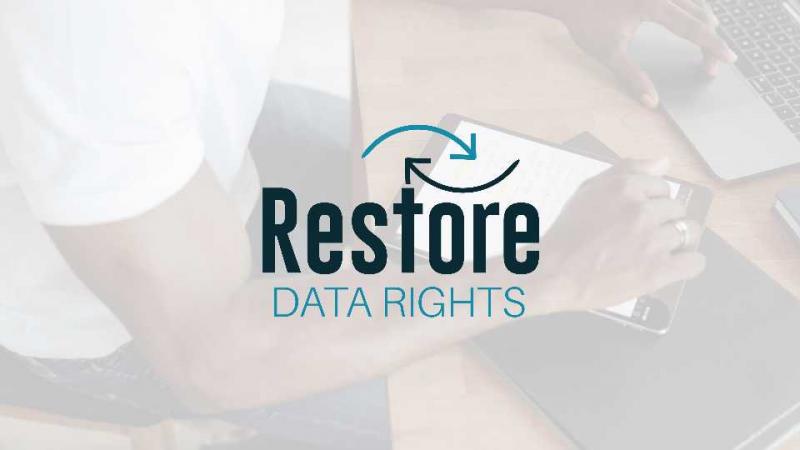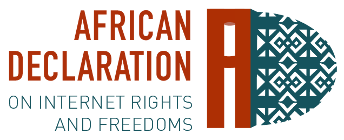Building cyberspace back better: Introducing the #RestoreDataRights movement
Building cyberspace back better: Introducing the #RestoreDataRights movement

2020 has been an incredibly challenging year for far too many people. News of death, disease, quarantine, lockdown, financial hardship, heightened anxiety and distress dominate headlines around the world. One of the things that distinguishes the COVID-19 pandemic from crises that have come before it is that our collective grief, loss, anxiety and hardship are expressed in cyberspace more than ever before. We text distant family members to express our love. We share our deepest fears with friends through video calls. We also delve into cyberspace to find relief, to stream films or play video games that provide an escape from the realities of lockdown and curfew. On social media, we share thoughts and views on how well (or not) our governments and global institutions have responded to the pandemic.
The sheer scale at which digital tools are being used during the COVID-19 pandemic is blurring the lines between cyberspace and reality far more rapidly than previously envisaged by even the most ardent techno-optimists. One just has to look at global equities over the past year to see how whole markets are being reshaped by the faith investors are placing in the future growth potential of the titans of the digital economy. Growth potential fuelled by the intrinsic value of digital data.
I’ve often said that what I love about working in the digital and data policy spaces is that for every positive application of a new digital, data-driven, technology there is at least one harm that might arise. The intentions that sit behind how digital technologies are applied often make the difference between whether something is used for the betterment of society or is designed to cause harm. More often than not, intentionality is in the eye of the beholder.
The intentions that sit behind how digital technologies are applied often make the difference between whether something is used for the betterment of society or is designed to cause harm.
In the context of the COVID-19 pandemic, this tension is particularly acute. Think of how data has been used by governments for instance. We are meant to trust our governments. They are meant to act in our best interests. In most countries, there is some form of social contract whereby citizens delegate authority to the state to act in certain ways in the collective interest. This authority sometimes includes the curtailment of freedoms and rights. During a pandemic, states have the right to do things like limit people’s right to move around or hold parties; so long that these restrictions are implemented with the public interest in mind, are limited by law and are subject to judicial oversight.
In cyberspace, the same principles apply. Personal data including individuals’ location data for instance, which ordinarily should be used only in very limited ways for specific purposes, can be used more freely by state authorities, including to do things like enforce limitations on people’s rights — so long as these restrictions are specific, limited by law, proportionate to the dangers posed by COVID-19 and undertaken in the public interest.
The big question then for societies facing unprecedented crises such as the COVID-19 pandemic is: at what point do we draw the line?
As I’ve written in the past, there are ways in which we can legally design interventions to be limited in times of crisis, by agreeing rules around how data should or shouldn’t be used. Finding the balance is incredibly tricky. In the United States and United Kingdom, authorities have come under fire because they have used data that was collected ostensibly for epidemiological purposes to enforce lockdowns — on the face of it, in violation of the well-established data governance principles that data should only be used for limited and specific purposes.
For the sceptics amongst us, we also can’t help but think of how powers granted to authorities in times of crisis have a tendency of sticking around far beyond their ‘best by’ date. Take for instance the extension of the USA’s Patriot Act in March 2020 for the 19th year running, one of the very few bipartisan acts taken in US politics this year. Historical precedents like this make human rights defenders twitchy, it makes us worry that COVID-19 might be a turning point towards a far more intrusive future in which government and corporate entities have deeper insight into — and therefore control over — our private lives.
However, things don’t have to be this way
As the COVID-19 pandemic has swept across Africa, a group of activists including the Paradigm Initiative and Media Rights Agenda in Nigeria, Africa Digital Rights Hub in Ghana, CIPESA in Uganda, Open Institute and Amnesty International in Kenya, Professor Tom Moultrie at the University of Cape Town in South Africa, and DataReady in the U.K., has been discussing how data used as part of the COVID-19 response should be governed in more transparent, inclusive, and accountable ways. The #RestoreDataRights movement, launched at a virtual event on 11 November 2020, has emerged as a result of these discussions.
What unites this movement is a passion and desire to ensure that our fundamental human rights — including those exercised in cyberspace and over our personal and sensitive data — are respected and upheld during, and after, the COVID-19 public health emergency. Central to the initiative is the #RestoreDataRights Declaration, a statement founded on the three cornerstones of good governance: transparency, inclusion and accountability, setting out how we believe data should be used as part of the COVID-19 response and in post-pandemic Africa. When we speak of ‘restoring’ data rights, we are talking about bringing back equilibrium. Restoring a social contract in cyberspace between the exercise of fundamental human rights and the use of data to keep citizens safe.
When we speak of ‘restoring’ data rights, we are talking about bringing back equilibrium. Restoring a social contract in cyberspace between the exercise of fundamental human rights and the use of data to keep citizens safe.
During our launch event, we heard from experts across government departments, development cooperation institutions, the digital rights community and the data for development community. From the point of the view of the initiative, it was an incredible opportunity to bring together this diverse coalition of interests and to put our minds together to think about how we can build cyberspace back better post-pandemic.
As we move forward as a movement, we want to work closely with those who were involved in our launch event
We want to partner with existing initiatives such as the African Declaration on Internet Rights and Freedoms, which is already doing the groundwork on so many of these issues, to amplify their work and find new points of synergy. We want to complement initiatives such as those led by the UN Economic Commission for Africa and Global Partnership for Sustainable Development data that are promoting public-private efforts to use data in ways that support decision-making. We want to learn from experts in countries such as Mauritius where the Data Protection Commissioner has been working hard to set an example of how data can be used responsibly to combat COVID-19 in transparent, inclusive and accountable ways; amplifying their learnings and helping others to improve.
“We trust when we see, and we trust when actions are transparent.” — Nnenna Nwakanma, Web Foundation
Ultimately, if we accept the premise that intentionality is everything when it comes to data and digital policy, in order for us to work together with these different interest groups to forge common intentions, our actions must be founded in trust. In relation to COVID-19, to achieve this trust and to help extrapolate it to the general public, as Nnenna Nwakanma from the Web Foundation put it during our launch event on the 11th, “we trust when we see, and we trust when actions are transparent.” We know that our movement to #RestoreDataRights will have been successful when we start to hear more people saying that they trust that their data is being used responsibly to defeat the pandemic.
Article was originally published on Tom's Medium: Building cyberspace back better: Introducing the #RestoreDataRights movement
